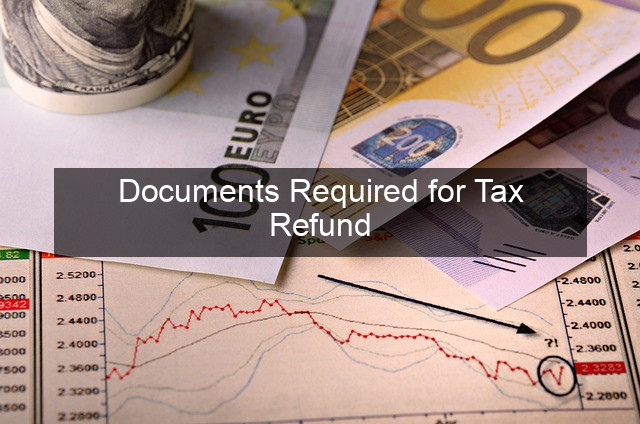Documents Required for Tax Refund
- Documents Required for Tax Refund
- Essential Tax Documents
- Income Documentation
- Dependent Information
- Deductions and Credits Documentation
- Itemized Deductions
- Education Credits
- Additional Documentation
- Previous Year's Tax Return
- Bank Account Information
- Record Keeping Tips for a Smooth Tax Season
- Organize Throughout the Year
- Utilize Tax Software or Professional Assistance
- Conclusion
- Frequently Asked Questions (FAQ)
- What if I'm missing a W-2 form?
- Can I file my taxes electronically without all my documents?
- Where can I find IRS forms and publications?
- What if I can't afford to pay my taxes?
- How long does it take to receive my refund?
- What should I do if I made a mistake on my tax return?
 “`html
“`html
Documents Required for Your Tax Refund
Tax season can be a stressful time, but the prospect of a refund can make it all worthwhile. However, navigating the process and gathering the necessary documentation can feel overwhelming. Knowing what documents you need beforehand can significantly streamline the process and ensure you receive your refund as quickly as possible. This guide provides a comprehensive overview of the essential documents required for claiming your tax refund, helping you avoid delays and frustration. We’ll cover everything from the fundamental forms like W-2s and 1099s to more specific documentation for various deductions and credits. Understanding these requirements will empower you to approach tax season with confidence and maximize your refund potential. Don’t leave money on the table; let’s get organized and prepare for a smooth tax filing experience.
Essential Tax Documents
Income Documentation
Perhaps the most crucial documents for filing your taxes are those that verify your income. These forms provide the IRS with a clear picture of your earnings and are the foundation of your tax return. Make sure to gather all relevant income documents to accurately report your earnings and avoid potential issues with the IRS.
Your W-2 form, provided by your employer, details your annual wages and the taxes withheld. Freelancers and independent contractors should look for 1099 forms, which report income from various sources. These documents are vital for calculating your taxable income and determining your refund amount.
Don’t forget about other income sources! If you received interest or dividends, you’ll need 1099-INT and 1099-DIV forms, respectively. Social Security benefits are reported on Form SSA-1099. Ensuring you have all necessary income documentation is the first step toward a successful tax filing.
Dependent Information
Claiming dependents can significantly impact your tax liability and potentially increase your refund. If you’re claiming dependents, you’ll need specific information to verify their eligibility.
The most important piece of information is their Social Security Number (SSN). Accurate SSN information is crucial for correctly claiming dependents and avoiding processing delays. Be sure to double-check these numbers for accuracy.
In addition to SSNs, you may need supporting documentation depending on the specific credits or deductions you’re claiming. For example, if you’re claiming childcare expenses, you’ll need receipts and the provider’s tax identification number. Keep organized records of all dependent-related expenses.
Deductions and Credits Documentation
Itemized Deductions
If you choose to itemize deductions, you’ll need to gather supporting documentation to substantiate your claims. Itemizing can potentially lead to a larger refund, but requires meticulous record-keeping.
For medical expenses, retain receipts for doctor visits, prescriptions, and other qualified medical costs. If you made charitable contributions, keep receipts or acknowledgment letters from the organizations. Homeowners can deduct mortgage interest, so keep your Form 1098 handy.
Remember, the IRS requires proof for all itemized deductions. Maintaining organized records throughout the year simplifies the tax filing process and ensures you can claim all eligible deductions.
Education Credits
Education-related expenses can qualify for valuable tax credits. If you paid tuition or incurred other educational expenses, you’ll need specific documentation to claim these credits.
Form 1098-T, Tuition Statement, is essential for claiming the American Opportunity or Lifetime Learning Credit. This form details the qualified education expenses paid during the year. Keep this form readily accessible when preparing your tax return.
Additionally, you may need receipts for textbooks, supplies, and other educational expenses. Ensure you have all the necessary documentation to maximize your education credit benefits.
Additional Documentation
Previous Year’s Tax Return
Having a copy of your previous year’s tax return can be incredibly helpful during the current filing season. It can serve as a reference point for your income, deductions, and credits from the prior year.
Referring to your previous return can help you identify any significant changes in your financial situation and ensure you’re claiming all eligible deductions and credits. It can also help you avoid making the same mistakes twice.
While not strictly required, having your prior year’s return on hand can significantly streamline the filing process and reduce potential errors.
Bank Account Information
If you’re expecting a refund, providing your bank account information will allow the IRS to directly deposit the funds, resulting in the fastest possible refund delivery. This avoids the delay of receiving a paper check.
You’ll need your bank’s routing number and your account number. Double-check this information to ensure accuracy and prevent any delays in receiving your refund.
Direct deposit is the quickest and most secure way to receive your tax refund. Ensure you have your accurate banking information readily available.
Record Keeping Tips for a Smooth Tax Season
Organize Throughout the Year
Don’t wait until tax season to start organizing your financial documents. Implement a system throughout the year to keep track of important tax-related information.
Create dedicated folders or use digital tools to store receipts, tax forms, and other relevant documents. This proactive approach will save you time and stress when it’s time to file.
Consistent organization eliminates the last-minute scramble for documents and ensures you have everything you need for a smooth tax filing experience.
Utilize Tax Software or Professional Assistance
Tax software can simplify the filing process and help you identify potential deductions and credits you might otherwise miss. Alternatively, consider consulting a tax professional for personalized guidance.
Tax software offers step-by-step instructions and automatically calculates your tax liability. Tax professionals can provide expert advice and help you navigate complex tax situations.
Whether you choose software or a professional, utilizing resources can make tax season significantly less daunting.
Conclusion
Preparing for tax season can seem like a daunting task, but understanding the required documents can make the process significantly smoother. By gathering your income documentation, information for dependents, and supporting documents for deductions and credits, you can confidently file your return and maximize your refund potential. Remember, organization is key. Keeping meticulous records throughout the year will save you time and stress when tax season rolls around. Don’t hesitate to utilize helpful resources like tax software or consult with a tax professional for personalized guidance. By taking the time to prepare and gather the necessary documents, you can approach tax season with confidence and ensure you receive the refund you deserve. Take control of your finances and make tax season a breeze.
Frequently Asked Questions (FAQ)
What if I’m missing a W-2 form?
If you’re missing a W-2, contact your employer as soon as possible. If you’re still unable to obtain it, the IRS provides Form 4852, Substitute for Form W-2, Wage and Tax Statement.
Can I file my taxes electronically without all my documents?
While you can technically start the process, it’s crucial to have all necessary documents before submitting your return to avoid errors and potential delays in processing your refund.
Where can I find IRS forms and publications?
You can find all IRS forms and publications on the official IRS website: www.irs.gov. They offer a wealth of information and resources to help you navigate the tax filing process.
What if I can’t afford to pay my taxes?
The IRS offers several payment options, including payment plans and offers in compromise. Visit their website or contact them directly to explore your options.
How long does it take to receive my refund?
The IRS typically issues refunds within 21 days of filing electronically if you choose direct deposit. Paper returns may take longer to process.
What should I do if I made a mistake on my tax return?
If you discover an error after filing, you can file an amended return using Form 1040-X, Amended U.S. Individual Income Tax Return.
“`


